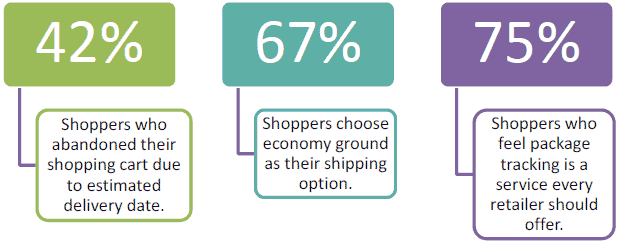3 Easy Tips to Reduce your eCommerce Fulfillment Costs
E-Retailers continue to fight a bittersweet battle when it comes to attracting and retaining consumers. While online purchasing continues to grow by double digits each year, consumers are becoming increasingly savvy and selective with their purchasing decisions. One of the most telling factors of online buying habits is revealed in the shopping cart – specifically when consumers view their shipping rate. According to a 2012 study by comScore, an estimated 42 percent of shoppers abandon the purchase path after seeing the ship costs. The desire for the product is no longer worth the additional expense of having it delivered to their doorstep.
Top Five Reasons for Shopping Cart Abandonment

Online retailers must walk a delicate tightrope between offering a low to no-cost shipping rate, while realizing a profit for their company. Some of the major retailers have mastered the art of online shipping by setting realistic expectations for their consumers prior to checkout. Here are a few examples:
- Old Navy offers free shipping for all orders over $50.
- Overstock offers a flat ship rate of $2.95 regardless the product price/weight.
- Amazon offers its Amazon Prime membership ($79 per year) that includes unlimited free-two day shipping on most products.
These are just a few ways large online retailers have overcome the shipping conundrum. But what if you’re not Old Navy, Overstock or Amazon? How can large to mid-sized online retailers remain competitive while keeping costs in check? Below are three simple tips to help brands trim unnecessary expenses from their supply chain while keeping consumers happy and coming back for more.
Start with customer service
What are the requirements of your online shoppers regarding the fulfillment and delivery process? Not all consumers insist on one or two-day shipping, provided they have a clear understanding of the timeframe in which their package is expected to arrive and can track orders. Brands who end up “over servicing” consumers with rapid turn times risk wasting money as well as delivering a poor brand experience when attention to detail is rushed.

Negotiate rates annually
Brands that ship a significant amount of product (over 100 pounds a day) should be able to contract with major carriers (FedEx, UPS, etc.) to negotiate discounted shipping rates on anannual basis. Fulfillment centers have the ability to do this across carriers – with savings of up to 50 percent – since they are shipping products for numerous brands and can leverage their buying power. In addition, most fulfillment providers offer six or more different ship methods for small parcels – giving companies the best possible model each and every time.
Analyze transportation daily
Fulfillment providers who factor in customer service requirements as well as weight and destination of each parcel can offer logistics strategies that provide significant cost savings. For example, by sorting packages geographically, fulfillment centers can zone skip parcels by using a regional trucking company to take packages to a more affordable ship destination. If there is an opportunity to completely fill a truck with parcels, additional cost savings can be realized.
Conclusion
With the exception of the top 10 online retailers (Amazon, Wal-Mart, etc.) the majority of large to mid-sized e-commerce brands can greatly benefit from partnering with a fulfillment provider. Unlike a traditional warehouse, the strategic mission of a fulfillment center is to turn product quickly through its facility. This means deploying a wide range of resources including negotiated shipping rates, transportation analysis and smart parcel sorting to maximize the return on its clients’ investment. Cutting costs throughout the small parcel supply chain offers a winning solution for both brands and their customers, who will reap the benefits of cost savings and satisfied consumers.
Learn more about PFC’s eCommerce fulfillment solutions or email us at info@pfcfulfills.com.

